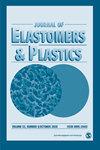Mechanical Testing and Characterization of a Swelling Elastomer
IF 1.6
4区 材料科学
Q4 MATERIALS SCIENCE, MULTIDISCIPLINARY
引用次数: 38
Abstract
Elastomers are being increasingly used for sealing and other applications in the oil and gas industry. Specifically developed elastomers possess durable properties and have the ability to withstand detrimental effects of heat, chemicals, and harsh environments. For successful modeling and simulation of various downhole processes, it is very important to determine the behavior of elastomer materials under realistic well conditions. Of special interest is the class known as swelling elastomers. This article reports some results from experiments conducted on mechanical testing and characterization of an inert (nonswelling) and a water-swelling elastomer (both belonging to the EPDM family) used for sealing purposes by a local petroleum development firm. Experiments were designed and conducted in accordance with standard ASTM test methods. Apart from regularly available testing equipment, some simple test rigs and fixtures were designed and fabricated. Elastomer behavior was tested for hardness, compression set (at different temperatures and for different periods of time), tensile set (for different periods of time), tensile properties (fracture strength and percent elongation), and swelling. In the swelling test, different sample geometries (unconfined samples and samples mounted on steel plate) were tested for a total duration of 1000 h (roughly 45 days) in salt solutions of different concentrations and at different temperatures. Results show that compression set increases with increasing temperature and testing time, while room temperature tensile set also increases with longer testing time. Compared to the inert elastomer (exhibiting nonlinear elastic behavior like normal rubbers), swelling elastomer surprisingly showed linear stress—strain response. As expected, the inert elastomer did not exhibit any change in volume, while the swelling elastomer showed significant volume/thickness increase with increasing test temperature and decreasing salt concentration.膨胀弹性体的力学测试和特性
在石油和天然气行业中,弹性体越来越多地用于密封和其他应用。专门开发的弹性体具有耐用性,能够承受热、化学物质和恶劣环境的有害影响。为了成功地对各种井下过程进行建模和仿真,确定弹性体材料在实际井况下的行为是非常重要的。特别令人感兴趣的是膨胀弹性体。本文报道了一家当地石油开发公司对用于密封目的的惰性(非膨胀)和水膨胀弹性体(均属于EPDM家族)进行的机械测试和表征的一些实验结果。实验按照ASTM标准试验方法设计和进行。除了常规可用的测试设备外,还设计和制造了一些简单的测试平台和夹具。测试了弹性体的硬度、压缩集(在不同温度和不同时间下)、拉伸集(在不同时间下)、拉伸性能(断裂强度和伸长率)和膨胀。在溶胀试验中,在不同浓度和不同温度的盐溶液中,对不同几何形状的样品(无约束样品和安装在钢板上的样品)进行了总持续时间1000小时(约45天)的测试。结果表明:压缩集密度随温度的升高和试验时间的延长而增大,室温拉伸集密度随试验时间的延长而增大。与惰性弹性体(表现出像普通橡胶一样的非线性弹性行为)相比,膨胀弹性体令人惊讶地表现出线性应力-应变响应。正如预期的那样,惰性弹性体的体积没有发生任何变化,而膨胀弹性体的体积/厚度随着测试温度的升高和盐浓度的降低而显著增加。
本文章由计算机程序翻译,如有差异,请以英文原文为准。
求助全文
约1分钟内获得全文
求助全文
来源期刊

Journal of Elastomers and Plastics
工程技术-材料科学:综合
CiteScore
3.30
自引率
5.90%
发文量
41
审稿时长
6 months
期刊介绍:
The Journal of Elastomers and Plastics is a high quality peer-reviewed journal which publishes original research on the development and marketing of elastomers and plastics and the area in between where the characteristics of both extremes are apparent. The journal covers: advances in chemistry, processing, properties and applications; new information on thermoplastic elastomers, reinforced elastomers, natural rubbers, blends and alloys, and fillers and additives.
 求助内容:
求助内容: 应助结果提醒方式:
应助结果提醒方式:


